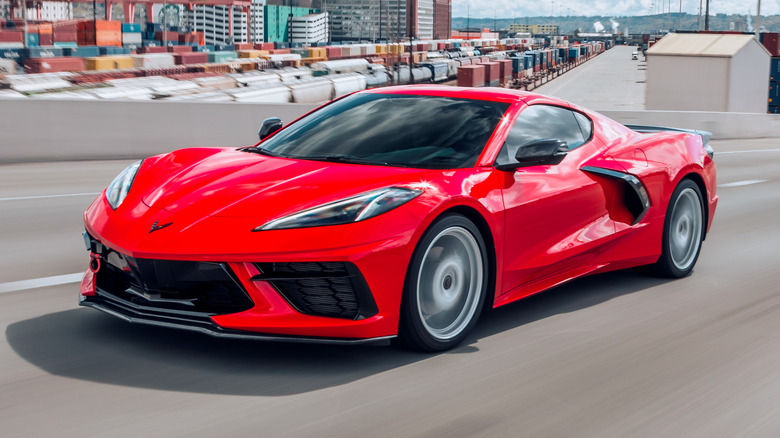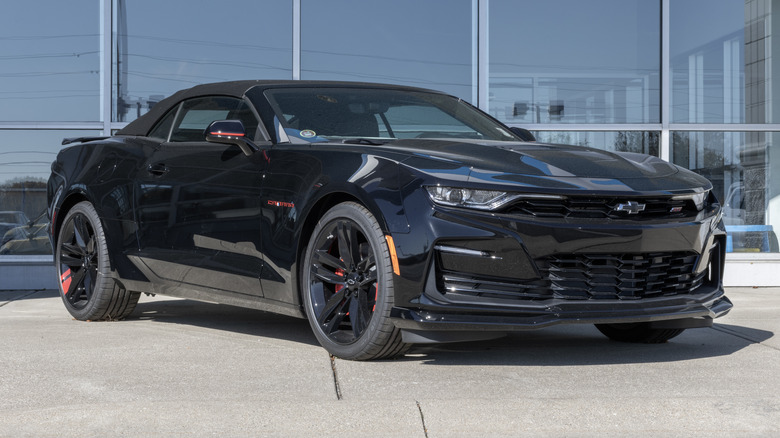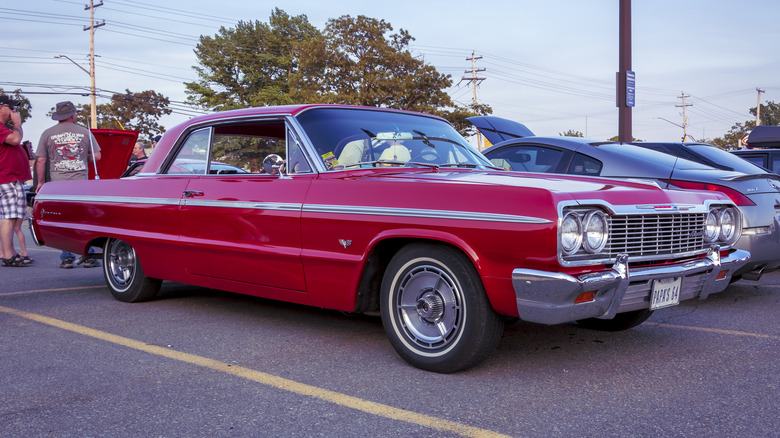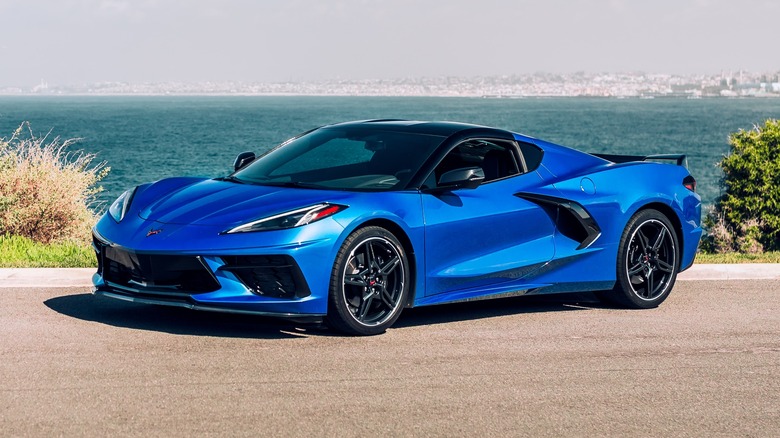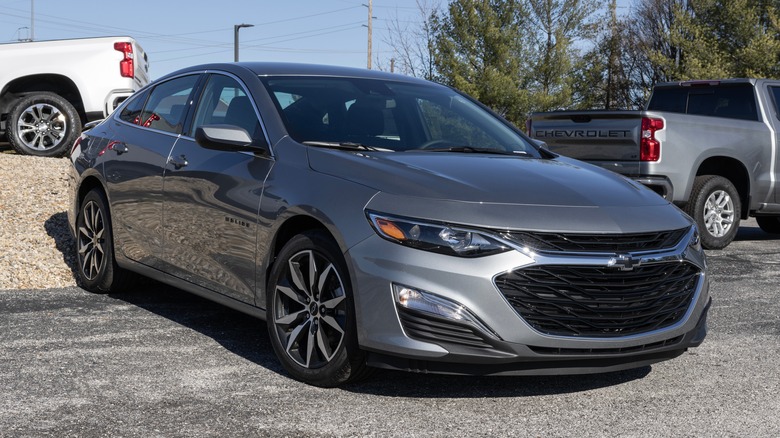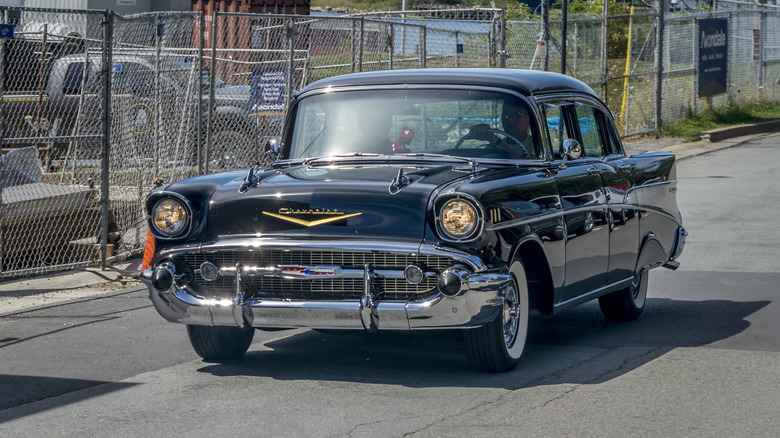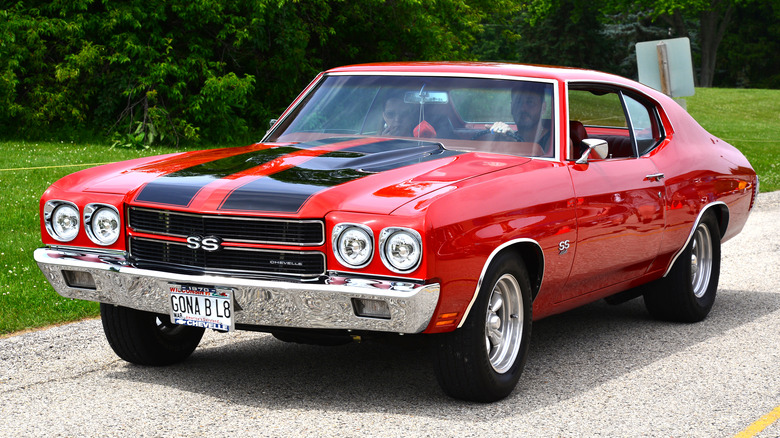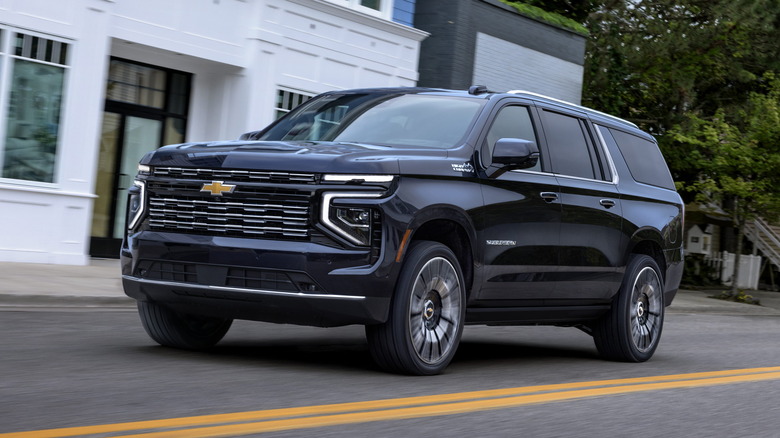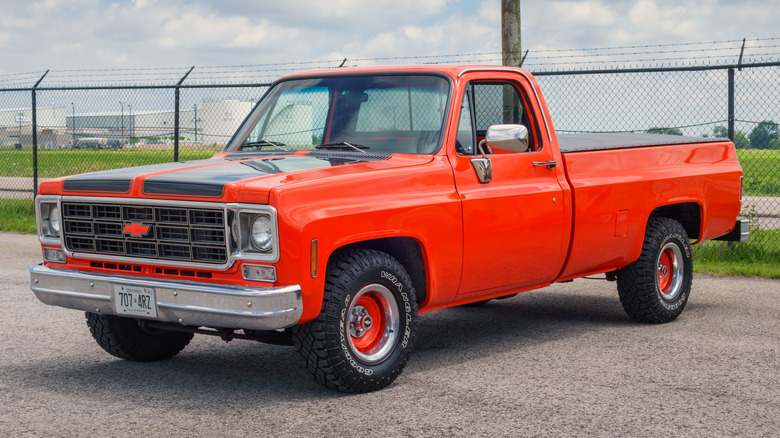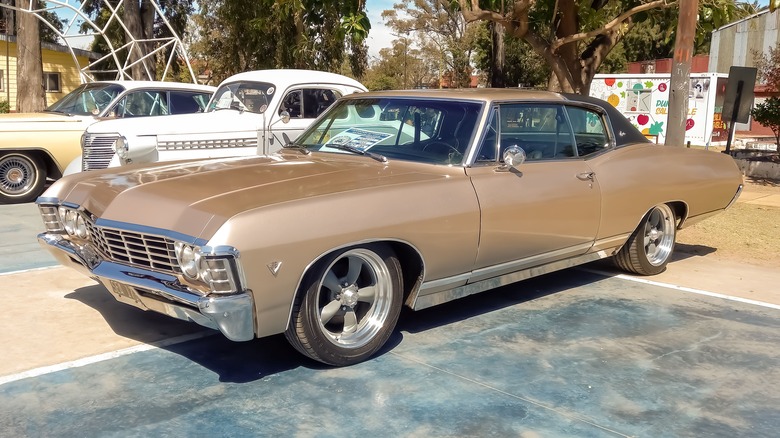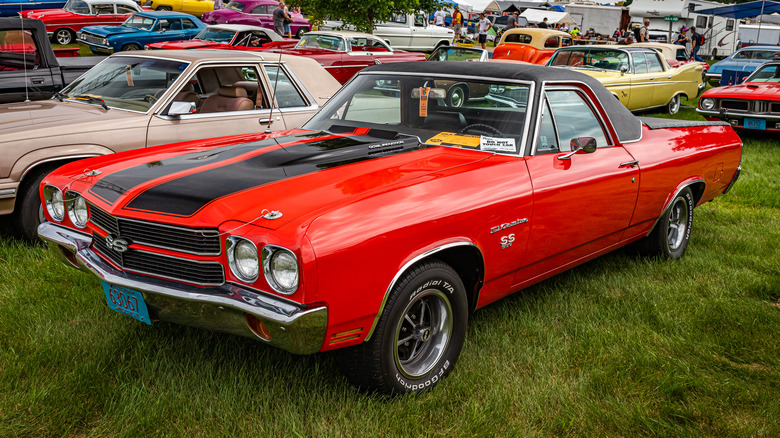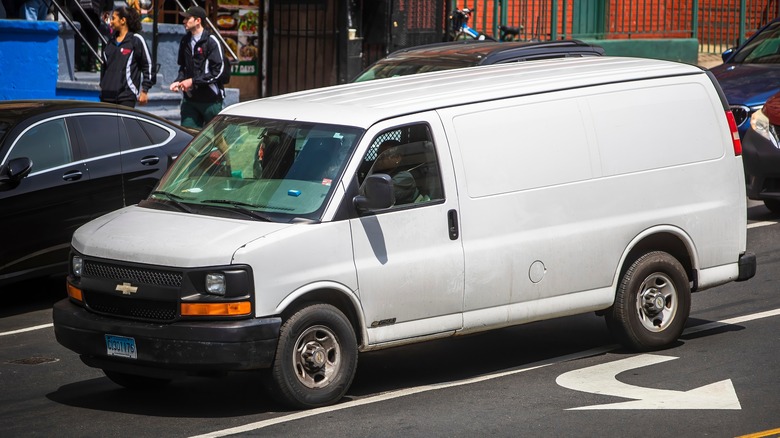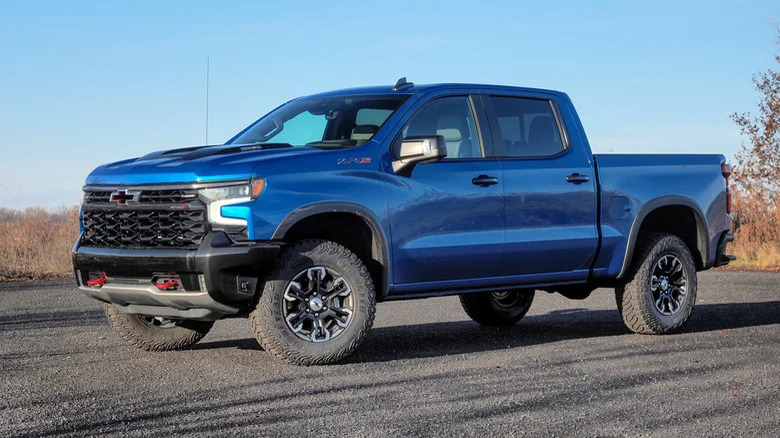12 Of The Most Successful Models In Chevrolet History
The Chevrolet brand is an integral part of the American automotive history, and unlike many heritage GM brands, it remained in strong health in 2024. Part of the reason for Chevy's success is that, despite the various troubles its parent company has endured over the decades, the brand has a wide catalog of iconic nameplates. These revered names cover a huge range of segments, from sports cars to pickup trucks, with many of them proving to be influential not just within GM, but also to the wider industry.
To compile this list of 12 particularly successful Chevrolet models, we evaluated the influence and sales trajectory for each popular vehicle over the years. Many of these top picks are household names in their own right, with rich histories that span decades of production. Each one has proved valuable to the Chevy brand by acting as a pivotal model in the company's history or proving to be a consistently popular stalwart in the brand's lineup. And in some cases, these vehicles have achieved both.
Chevrolet Camaro
While the Camaro was first conceived as a rushed response to the sales success of the Ford Mustang, it turned out to be one of the brand's best loved nameplates. In the mid '60s, Chevy bosses weren't convinced that an affordable four-seater sports car would sell well, so they overlooked the efforts from GM designers to create one. However, after watching the Mustang move nearly 400,000 units in its first year, GM leadership had an abrupt change of heart and ordered a Mustang rival to be designed and built as quickly as possible.
The first generation Camaro launched in 1967 and was a hit with buyers, but it couldn't quite match the Mustang's feverish hype. A second generation debuted in 1970 with significant revisions. It proved to be much longer lived, surviving until the early '80s, when it was replaced by the third generation Camaro. This new update brought more power and improved handling, with the most potent variants making up to 245 horsepower.
The fourth generation debuted in 1993 and built on the success of its predecessor before being retired in 2002 with no direct successor. It would take until 2006 for the next generation Camaro concept to be unveiled, and until the 2010 model year for the cars to reach dealerships. It was followed up by a sixth generation that was retired in early 2024. Although, bosses hinted that a new Camaro generation would eventually debut.
Chevrolet Impala
The original Impala debuted in 1958 as an offshoot of the Bel Air, but it only took one model year for it to become a standalone model. The introduction of the Impala SS in the early '60s made the nameplate a muscle icon, and by the middle of the decade, the car had hit the peak of its popularity. While the 1964 Impala has a strong grip on pop culture, it was the 1965 model that proved to be the peak of Impala sales thanks to over a million units sold in a single year.
The Impala continued to be successful throughout the '60s and into the '70s even after it shrank in both size and power output as a result of the oil crisis and subsequent changing tastes. A reshuffle of Chevy's lineup over the course of the decade saw the Impala become the base-spec model while the Caprice was offered as the more upscale choice. Thanks to this new role, the Impala gained popularity with fleet buyers.
The nameplate was retired in the mid '80s, and it would take until 1994 for it to reappear on a production car. The '94 Impala SS was a more muscular Caprice with an LT1 V8 engine and achieved collectible status thanks to its sleeper looks and halt in production just two years later in 1996. The nameplate returned in 2000 as a fleet-ready, front-wheel drive sedan with further iterations remaining in production until falling sedan sales saw the Impala get axed again in 2020.
Chevrolet Corvette
It's not only the most iconic Chevy nameplate, but one of the most revered in all of American automotive industry. Every generation of the Chevrolet Corvette has its fans, from the classic C1 to the supercar-baiting mid-engine C8. First introduced in 1953, the C1 was far from a sales success thanks to its relatively modest performance. By the end of the generation, however, its power had been boosted considerably thanks to the introduction of a V8 engine, which laid the foundation for the model's success.
Throughout the '60s, even more powerful variants of the Corvette were launched, the most potent of which are highly sought after by well-heeled collectors. The '70s, by contrast, saw power outputs shrink back down to pre-muscle car levels thanks to restrictive legislation and the effects of the oil crisis. It would take until the '90s for the Corvette to be truly competitive against its international rivals once again.
Each generation from the C5 to the C7 focused on delivering maximum performance at the minimum price, all while refining the Corvette's handling to better compete with offerings from across the pond. The launch of the C8 Corvette in 2020 brought a major change: For the first time in its production history, the Corvette became a mid-engined sports car. The 2023 Z06 took the Corvette to new performance highs, and rumors at the time suggested that even more powerful Corvettes were on the way.
Chevrolet Malibu
While the Malibu never gained the star power or collectibility of other Chevrolet models, it remained a key part of the Bow Tie's lineup for many years. Based on the Chevelle, it was first introduced in 1964 and was available in a range of body styles. A second generation appeared in 1968, which saw the Malibu grow larger and plusher. Although, by the early '70s, it was already in need of replacement. The 1973 model year saw the launch of the third generation, which again grew in size, but not in power.
Like most American cars of the era, the Malibu was downsized in the latter half of the '70s, but its smaller, more efficient form failed to win over buyers in large enough numbers to prevent it from being axed in 1983. The nameplate wouldn't resurface again until 1997 where it was positioned as a reasonably priced, front-wheel drive sedan. Following generations would improve on the car's all-rounder appeal, adding more powerful top-spec variants while keeping entry-level trims affordable.
Over the years, the Malibu arguably got better and better, with the most recent generation representing solid value for the money while delivering a surprisingly high level of interior technology and equally high levels of efficiency. However, as sedan sales declined as buyers shifted to SUVs and crossovers, the Malibu was mostly overlooked. Its slow sales saw the model axed in 2024. However, since the Malibu's launch over sixty years ago, Chevrolet sold over 10 million units of this automotive staple.
Chevrolet Bel Air
It's best known as the top-spec variant of the tri-five Chevy, produced from 1955 to 1957, but the Bel Air name has a lot more history besides those famous model years. It was first used in 1950 to designate the brand's two-door hardtop models. In 1953, the Bel-Air was then used to refer to various styles in top-spec trim before a 1955 overhaul brought new powertrain options, technology, and futuristic styling, each of which was further improved over the following model years. The second generation Bel Air was produced through 1957 before being replaced in 1958 by the third generation as Chevy consistently tinkered with the Bel-Air nameplate.
The fourth generation launched just one year later in 1959, but this time around, GM designers give the Bel Air a drastic styling overhaul and a new frame. Like its predecessors, this generation was also short-lived, as the fifth generation launched in 1961 with further major revisions. Chevy would continue the cycle of frequently upgrading the model throughout the '60s, offering larger, more powerful engines and an increasing array of cutting-edge features.
By 1971, however, the Bel Air had become overshadowed by other cars in the brand's lineup. The last generation that was sold in the U.S. was mostly relegated to being a fleet car. While the Bel-Air was ultimately axed in the U.S. in 1975, production continued in Canada until 1980. By that time, the car was a shadow of its former self, but its earlier glory days ensured its place among the brand's most successful nameplates.
Chevrolet Chevelle
Another classic nameplate that saw its peak in the heyday of the muscle car, the second generation Chevelle is the most famous — and the most powerful. The 1970 Chevelle SS 454 offered 450 horsepower and was one of the last great muscle cars produced before new emissions regulations and the oil crisis provided a fatal one-two blow to the muscle car industry. The Chevelle had originally debuted in 1964 as a mid-size offering, below the Impala, but it didn't take long for it to carve a reputation as the preffered muscle car option in Chevy's lineup.
The second generation Chevelle was launched in 1968 and proved to be a commercial success as buyers were drawn into purchasing the car because of its wide variation of trims as well as its powerful variants. Production peaked in 1970 then quickly tapered off in the following years. The third generation Chevelle, launched in 1973, reduced both power output and the number of body styles available. It included the Malibu, another highly successful Chevy nameplate, as a trim level, but by 1977 the Chevelle nameplate was retired altogether as the Malibu took its place.
Chevrolet Suburban
The Chevy Suburban holds the distinction of being the longest running nameplate in automotive history. It was first used in 1935 and remained in continuous use as of this writing. Over its 90-odd year production, the basic formula of the Suburban has been remarkably consistent: It's a large, truck-based people-mover that prioritized interior space thanks to a raised roofline. In short, an SUV long before the term even existed.
To date, there have been 12 generations of the Suburban, with the most recent generation launching for the 2021 model year. Each remained geared towards family hauling. Although, over the decades the SUV has also been built for a variety of commercial and government uses. Alongside the related Tahoe, the Suburban continues to be a strong seller for Chevrolet with the brand selling more than one million vehicles in the last two decades, according to data from CarFigures. With SUVs remaining a highly popular — and very lucrative — segment in 2024, the Suburban's popularity could see even more longevity.
Chevrolet C/K
Built to replace Chevy's range of Task Force trucks, the C/K series would hit new heights both in terms of sales success and capability. The model was introduced in 1960 and featured several distinctive design characteristics including a boxier overall shape and a flat hood. It was first and foremost a work vehicle, but as the second generation C/K launched in 1967, the Bow Tie brand expanded the customer base by offering more creature comforts. It became a massive commercial success and helped pave the way for the idea of a pickup as both an everyday vehicle and a tool for work. The launch of the K5 Blazer in 1969 further evolved the series and became a hit in its own right.
The C/K nameplate continued evolving with the third generation in 1973 as Chevy expanded the truck's range of engine and body style options. The square body, which GM referred to as the Rounded Line, proved so successful that the formula remained mostly unchanged with the launch of the fourth generation in 1988, which stayed in production until 2002. No body work had lasted that long in Chevy truck history. Despite its lengthy run, the fourth generation was ultimately replaced by a new truck bearing the Silverado nameplate, which had previously been a C/K trim.
Chevrolet Caprice
Marketed alongside the full-size Impala, the Caprice started out as an upscale trim before eventually separating into a standalone model. It first debuted in 1965 as a 1966 model year with a unique roof and added upscale extras to differentiate it from the Impala. While the Impala line branched out into many forms over its production — it could be optioned as an everyday cruiser or a muscle car — the Caprice was more consistent in its appeal. It was an Impala with added extras and remained mostly that way over its decades on sale.
Like the Impala, the Caprice hit its sales peak in the mid '60s with a steady decline heading into the '70s as its power output shrank and new safety laws added restrictions on design. In 1977, Chevrolet shrank its full-size cars significantly, adapting to buyers' preferences. The Caprice enjoyed a few years of impressive sales during the end of the decade, but tastes changed again in the early '80s.
Buyers began to favor smaller cars like the Cavalier — which became the best selling car in America in 1984 and 1985 — but the Caprice continued on regardless. A new fourth generation, still based on the aging B-Body, provided a small boost in sales, but it wasn't enough to stop the long-running nameplate from being finally axed in North America in 1996.
Chevrolet El Camino
In May 2024 SlashGear crowned the El Camino one of the classic trucks we'd most like to see make a comeback, but whether the nameplate would ever be resurrected remained to be seen at the time. Like the Camaro, the first generation El Camino was not a success after being introduced in 1959 to compete against the Ford Ranchero. It was withdrawn due to poor sales, but in 1964, a second generation was launched, based on the Chevelle. This iteration proved to be more of a hit, but it wasn't until the third generation was unveiled in 1968 that the El Camino really shifted into gear.
The car-based pickup could be optioned that year with a powerful 396 V8 engine, which later evolved into the El Camino SS package in 1969. Upgraded brakes and special trim accents were included for the SS alongside the engine upgrade. The 1970 SS gained the even fiercer 454 V8, churning out 450 horsepower. Like all muscle cars, the El Camino became gradually more restrained over the following model years. Although, that didn't hurt its sales figures, which peaked in 1973.
The '70s saw the El Camino evolve with changing buyer tastes, remaining reasonably popular even without the fire-breathing variants that had defined its golden era. It was eventually retired in 1987, almost thirty years after the first generation was unveiled.
Chevrolet Express
It's far from the most sought after Chevrolet model, and likely will neverg age into collectible status, but the humble Chevy Express van is a quiet star of the brand's lineup. More than three million examples of the Express and its sibling the GMC Savana have reportedly left the production line since the van was first launched in 1996, and as of this writing, it continues to be offered in Chevy's current lineup. The van has changed very little in the decades since its launch, quite simply because it hasn't needed to. It's a tried and tested formula even if that comes at the expense of modern luxury and technology.
In 2022, reports suggested that the Express might be replaced in 2026 by an electric-powered successor, which would be a major change for the reliable nameplate. However, by early 2024, Chevy appeared to have backed away from the EV plan. Instead, the Express would receive some sort of revamp in the near future, but details were scarce on what would be changed. As of this writing, the Express soldiers on unchanged.
Chevrolet Silverado
The Chevrolet Silverado has evolved significantly over its years on sale, originally serving as the replacement for the brand's long-running C/K series. Fighting off ever-present competition from Ford and the Dodge Ram, the Silverado has proved a consistently popular choice among truck buyers, with data from CarFigures showing that Chevrolet has sold around 10 million of the truck in the last two decades alone. The model has seemingly future-proofed its appeal, too, as the long awaited Silverado EV was scheduled to hit dealerships in summer 2024. The launch variant offers more than 400 miles of range and boasts up to 754 horsepower depending on its drive mode.
Whether the electric Silverado becomes a hit, or the ICE truck continues to be the favored choice for most buyers, it seems the Silverado's popularity is set to continue either way. While the EV is only available in road-focused variants as of this writing, the excellent Silverado ZR2 caters to the off-roading crowd. On the other end of the price spectrum, the base Silverado is still an affordable work truck making the lineup more broad than ever. As a result, the Chevy Silverado seemed primed for further sales success in the coming years.
